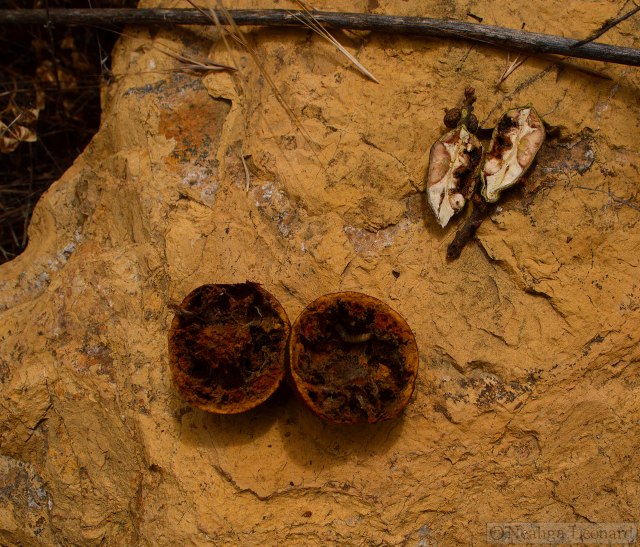The word “galling” is particularly evocative. In its most simple form something that galls is merely annoying or vexing, but the true definition connotes annoyance taken to an extreme level. The sort of thing that will do you no harm but rankles tremendously; much like being forced to pay taxes to support actions you object to.
For us these annoyances are mental and emotional, for plants these galls are physical but are often merely annoyances for them as well.
Many plants suffer from galls and the galls are so singular in form that they can be reliably used to identify individual parasite species. A fantastic book on identifying plant galls for the California region is the Field Guide to Plant Galls of California and Other Western States.
Oak trees seem to be particularly susceptible to parasites of all sorts and a common manifestation is the Oak Apple Gall, most often seen as a hard, woody ball dangling from a twig. These galls are created by the Oak Apple Gall Wasp, a common name for a variety of small wasps that inject their eggs into the midrib of a developing leaf and chemically trick the tree into growing a protective shell for the developing larvae. Despite appearing woody when dried, this type of gall is actually a modified leaf. The delicacy of these galls is more easily seen when they are still green.
The developing wasps browse on the oak tissue and are often preyed upon or parasitized by other animals, including birds, raccoons, and a whole host of insects, other wasps included. Some insects use the gall for their own protection, sharing the space with the wasp larvae.
Certain Oak Apple Galls, the Iron Galls, in Europe were collected to make ink. For 1500 years ink make from the iron gall was the primary source of writing quality ink in the Western Hemisphere. For anyone interested Evan Lindquest provides detailed instructions on how to make your own iron gall ink.
Like may things we have a long history with there is a great body of mythology and folk-lore that has accumulated around these galls.
Many galls are hard and woody, there is a Twig Gall I sliced in half in the photo above. It appears to be empty, but a dark brown patch filled with frass (insect excrement) can be seen winding its way though the bloated tissue.
Oak Apple Galls often fall from the tree, but Twig Galls are a more permanent fixture of the tree.
Right now the Scrub Oak is blooming along the coastal mountains in Southern California. The twig galls are uniformly clustered near the tips of the branches, with many of them crowned by small clusters of flowers. This provides a bit of insight into the formation of these and other galls.
The gall must be grown, and while the living plant cells are constantly dividing, the true growth of a woody plant takes place at the tips of the branches and roots, or at the apical meristem of each limb. The cells in the apical meristem are undifferentiated,having the potential to become a wide variety of plant organs, much like stem cells in animals. The parasite, be it a wasp, bacteria, or virus, co-opts these “stem” cells and gives them new instructions. In a way the galls are akin to a tightly controlled cancer initiated by the parasite organism.
The Twig Galls I was looking at today were insect formed and, as such, the insect needs to escape the protective structure once it is mature. Many of the galls had little holes in them showing where the little wasps has crawled out.
The variation in galls is astounding. I have seen leaf galls on wild roses that look like tiny sea-urchins dipped in vermillion. There are galls that not only force the plant to grow a protective structure around it, but that trick the plant into producing nectar to attract ants which in turn protect the growing larvae from predators. Many are extremely colorful and the shapes are widely varied.
The common theme is that the galls are all formed in developing tissue, leaves, new twigs, flowers, roots, or fruit.
Some of the Ichneumonidae wasps that make so many of the galls we see have developed a biological metallurgy, evolving zinc and manganese coated ovipositors which they use to inject chemicals and hormones into the plants they co-opt.
The specificity and regularity of the galls and the relationships between the plants and the gall formers speaks to a lengthy and complicated evolutionary history.
We pride ourselves (or are horrified by) our newly found ability to genetically manipulate plants and animals. In truth, we have a long way to go before we catch up to what we often mistakenly call the “humble” insects.







Great post!
Glad you enjoyed it
Interesting post, nice photos!
Thanks!
[…] What are these red of growths? They are called Galls and are caused by parasites, with different parasites creating Galls in different shapes and sizes. For example, Oak apple Galls are caused by wasps who inject their eggs into the branches of the tree and then tree then grows a hard protective layer around the eggs forming a ball. These Galls though are not caused by wasps but caused by mites. This doesn’t mean the tree is dying, just that the tree is trying to protect itself. You can read some more about Galls here. […]